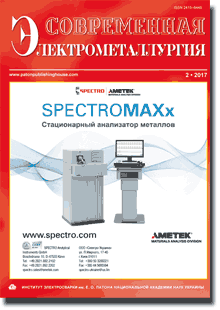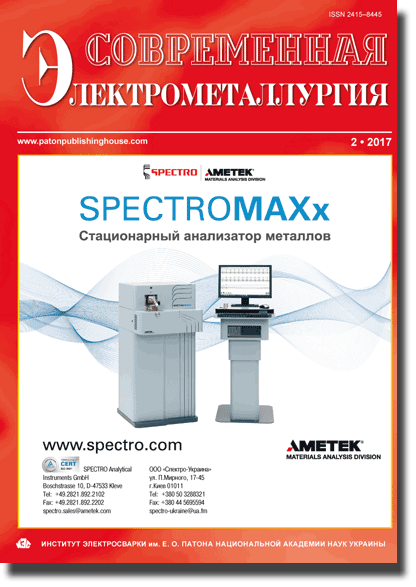| 2017 №02 (02) |
DOI of Article 10.15407/sem2017.02.03 |
2017 №02 (04) |

Electrometallurgy Today (Sovremennaya Elektrometallurgiya), 2017, #2, 17-20 pages
Melting of ingots of Ti–Nb–Si–Zr system titanium alloys by the method of electron beam melting
N.I. Grechanyuk1, L.D. Kulak1, N.N. Kuzmenko1, Yu.O. Smashnyuk2, A.V. Demchishin1, A.E. Fisk1
1I.M. Frantsevich Institute of Problems of Materials Science of the NAS of Ukraine. 3, Krzhizhanovsky str., Kiev-142, 03680. E-mail:dir.@ipms.kiev.ua
2R&P enterprise «Eltehmash». 25 Vatutin str., Vinnitsa, 21011. E-mail:vin25ebt@ukr.net
Technological peculiarities of producing complexly-alloyed alloys of Ti-Nb-Si-Z system of medical purposes are considered. The feasibility of formation of ingots of titanium-based alloys within the relatively narrow ranges of concentrations of alloying components, wt.%: 11…13 Nb; 0.9…1.1 Si; 1.9…2.2 Zr is shown. Structure, phase composition and mechanical properties of mentioned materials in cast state were studied. Ref. 4, Tables 2, Figures 3.
Keywords: electron beam melting; medicine; titanium alloy; niobium; zirconium; silicon
References
1. Fisk Andrewe et al. (2014) Titanium based ceramic reinforced alloy for use in medical implants. Pat. US 20140 105781 A1.2. Ladokhin S. V., Levitsky N. I., Lapshuk T. V. i dr. (2015) Primeneniye elektronno-luchevoy plavki dlya polucheniya izdely meditsinskogo naznacheniya. Metall i litye Ukrainy, 4, 7–11. [in Russian].
3. Niinomi M. (2008) Mechanical biocompatibility of titanium alloys for biomedical application. J. Mech. Behav. Biomed. Mater., 1, 30–42. https://doi.org/10.1016/j.jmbbm.2007.07.001
4. Anselme K., Noel В., Hardouin P. (1999) human osteoblast adhesion on titanium alloy, stainless steel, glass and plastic substrates with same surface topography. J. Mater. Sci. Mater. Med., 10, № 12, 815–819.
The cost of subscription/purchase order journals or individual articles
| Journal/Currency | Annual Set | 1 issue printed |
1 issue |
one article |
| TPWJ/USD | 384 $ | 32 $ | 26 $ | 13 $ |
| TPWJ/EUR | 348 € | 29 € | 24 € | 12 € |
| TPWJ/UAH | 7200 UAH | 600 UAH | 600 UAH | 280 UAH |
| AS/UAH | 1800 UAH | 300 UAH | 300 UAH | 150 UAH |
| AS/USD | 192 $ | 32 $ | 26 $ | 13 $ |
| AS/EUR | 180 € | 30 € | 25 € | 12 € |
| SEM/UAH | 1200 UAH | 300 UAH | 300 UAH | 150 UAH |
| SEM/USD | 128 $ | 32 $ | 26 $ | 13 $ |
| SEM/EUR | 120 € | 30 € | 25 € | 12 € |
| TDNK/UAH | 1200 UAH | 300 UAH | 300 UAH | 150 UAH |
| TDNK/USD | 128 $ | 32 $ | 26 $ | 13 $ |
| TDNK/EUR | 120 € | 30 € | 25 € | 15 € |
AS = «Automatic Welding» - 6 issues per year;
TPWJ = «PATON WELDING JOURNAL» - 12 issues per year;
SEM = «Electrometallurgy Today» - 4 issues per year;
TDNK = «Technical Diagnostics and Non-Destructive Testing» - 4 issues per year.





